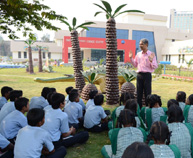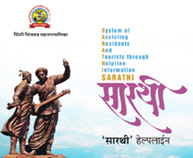
History
Pimpri Chinchwad is known by many nomenclatures worldwide. Widely famous as Industrial Township, it is also recognized as Detroit of the East with the presence of many national and multinational automobile companies.Blessed with rich cultural heritage and history, Pimpri Chinchwad is the birthplace of many freedom fighters like Chaphekar and Halbe. Shri Chapekar took active part in freedom struggle against oppressive British rule. He was hanged for the assassination of the infamous British officer Walter Charles Rand who had caused distress among the masses and committed atrocities in the Plague hit city of Pune. A monument dedicated to Chaphekar brothers has been erected at the centre of the town.
This township is also the birthplace of Ganesh devotee & Saint MoryaGosavi whose holy tomb is located at Chinchwad. Two thousand years ago, the township was ruled by King Bhoj. The capital of his earstwhile empire was Bhojapur, which in present day is known as Bhosari. The Maharashtra Industrial Development Corporation (MIDC) has its base in Bhosari.
The township is situated at a height of 530 ft above the sea level. It is blessed with salubrious climate all the year round. Excavated by Archaeologists, the 2000 year old 'Artist temple' and the "Artist Mahal" situated at Bhosari or the erstwhile Bhojapur is one of the monuments of interest in the township. King Bhoj is known to have organized many cultural events here. The artists performing at the Artist Mahal had their residence three kilometers away from the capital city. During excavation of the city, Archaeologists have also discovered many artifacts like pots and other equipments, which date back to 200 A.D.
The village of Pimpri Chinchwad had a gate entrance gate which was 14 feet high. Its existence has been noted in 1885 Bombay gazette. Some writings on stone, dating back to the tenth century have been found in the township.
The township of Pimpri Chinchwad was also a part of the Yadav Dynasty between AD 850 to 1310. Many sculptures of people who died in wars and relics relating to this ancient past have been found. Tourist can visit ancient temples of lord Khandoba, Mhasoba, veer Chandoba and Swarswati. Bhosari village has a history dating to Gautam Buddha's era. Other places of interest in Pimpri Chinchwad are KhandobaMahal, which houses a temple of lord Khandoba. Every year Lakhs of pilgrims visit the temple town of Alandi near Bhosari, and pray at the Samadhi (Tomb) of most revered Saint Dnyansehwar. Pimpri Chinchwad has a large number of lord Ganesh devotees. People from allover India come to visit the tomb of the great priest and Ganesh devotee, MorayaGosavi.
A folk tale about MoryaGosavi mentions that Two Ganesh devotees Vaman Narayan and BhatShaligram, natives of Bidar village in Karnataka state came to Morgaon, a pilgrim center in Maharashtra in 1330 with their wives. At Morgaon on the bank of a river, BhatShaligram worshipped a holy tree dedicated to lord Ganesh. Within a year he was blessed with a son. He named him Morya. One day Morya became critically ill and didnot recover for a long time. His parents were worried and prayed to Lord Ganesha for Moraya’s wellbeing and good health. During this period there was a priest who treated Morya and saved his life. Later the priest (Gosavi) gave preaching to Morya and stayed at NayanBharati Chinchwad where he subsequently took Samadhi (went into tomb). Since then the Bhat family including Moraya came to be known as Gosavi
MoryaGosavi worshiped Lord Ganesh (Moreshawar) at Morgaon. He attained and realised the presence of Lord Morya in himself. Later due to hindrance in his worship he left Morgaon and started worshipping Lord Ganesh at a jungle near Tathwade near Chinchwad. On chathurthii.e every fourth day after full moon he used to visit Theur. On the request of Lord Ganesh devotees from Chinchwad, MoryaGosavi started worshiping at the bank of the Pavana River. MoryaGosavi got married in the year 1470 to a girl Uma from Tathwade village in Chinchwad. He always used to travel to Theur, Ranjangaon and Chinchwad to worhip Lord Ganesh. In the year 1481 he was blessed with a son. He named him Chintamani. Later on, this boy became famous as great devotee of Lord Ganesh and Saint, the elder ChintamaniMaharaj.
MoryaGosavi was devotee all his life; he dedicated his life towards devotion of Lord Ganesh. His wife Umabai died in the year 1556 and his Guru Shree NayanBharati undertook Samadhi. MorayaGosavi felt that he had completed his life work and in the year 1556 decided to take Samadhi (go alive in a tomb). Emperor Humayun the Mugalrular at Delhi during his exile at Gujarat, came to know about the popularity and devotion of MoryaGosavi. Emperor Humayun pleaded him to save him from his plight. MoryaGosavi arranged for safe passage of the king to Kabul. Soon, Humayun's fortunes changed and he became Emperor of Delhi. As a token of gratitude the Emperor sent gifts to Morya. This incident has been noted in a history book written by Parasnis and Martin called “Sanads and Letters of Humayun”




